How to choose decorative screens for radiators: an overview
In our time, the design of premises to plan quite easily even with a relatively small budget. Because it is possible to decorate absolutely any parts of the room with ready-made products.
No exception, and such indispensable attributes of any room, as radiators. In this article we will understand how to decorate a heating battery - consider all popular solutions.
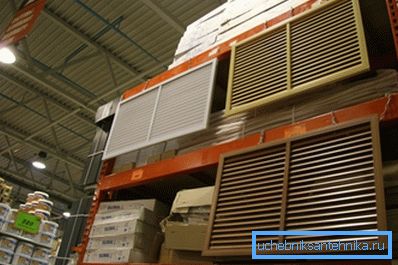
Let's start with the most "exciting" question.
Is it possible to "close" the space between the radiator and the room
It's really simple. Of course, if the heater is literally closed with a monolithic shield, then the heat will not spread around the room. But the fact is that the decor of the radiator is performed mainly with the help of gratings, the space of the cells of which allows the warm air to freely enter the room.
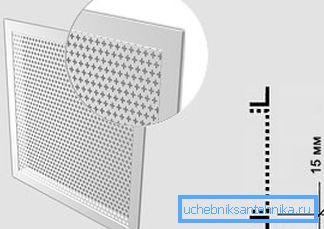
What are the pros and cons of such a solution will be considered in the comparative table below.
| Benefits: | Disadvantages: |
|
|
It turns out that technology, in principle, has more advantages than disadvantages. Therefore, we continue and proceed directly to the review of products.
Types of grids
It should be noted that decorative grilles for radiators are primarily divided into three main types:
- hinged products in the form of boxes, which close the heater from all sides.
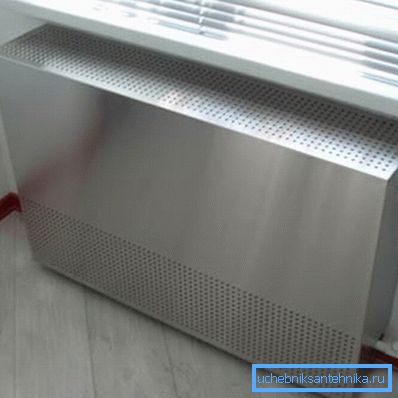
- mounted screens that close the radiator only at the front and top.

- flat panels. Products actually apply when the battery is located in a niche, as if inside a wall.
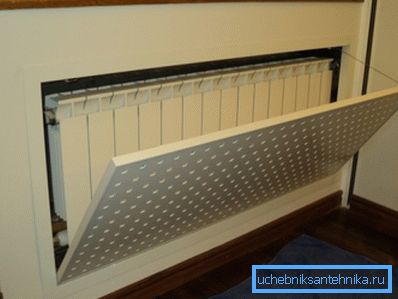
Now let's deal with the materials of manufacture.
Hardware
Such decorative grilles for radiators can be made from galvanized steel of different colors, as well as from cast iron or ordinary iron.
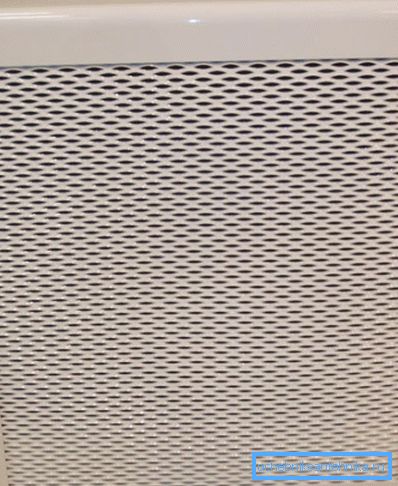
The advantages of this option are:
- Very good level of heat transfer. The metal heats up quickly and practically does not trap heat from the battery.
- It is easy to care for such a surface - the plane can be wiped with a cloth, and you can affect the metal and the pressure of water. There will be no deformations.
- The price of the material is quite acceptable. True, this applies only to products made of galvanized steel - forged or cast iron grilles cost a lot of money.
As for the shortcomings, we can single out one thing - the metal is not suitable for every style of the interior.
But in general, the option is very decent. Let's go further.
Glass panels
Such panels are distinguished by their sophisticated appearance and, in principle, in a sense, can be considered an exclusive solution. These screens are made of stained glass or tempered glass - usually their thickness does not exceed 8 mm.
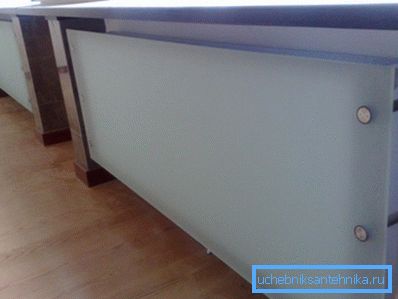
A cheaper analogue of glass is a lattice made of acrylic or triplex.
Decorative possibilities in all cases are very wide, since absolutely drawing can be applied to the grid.
Now consider how the decor of the radiator is performed using a very affordable and always relevant material.
Wooden lattices
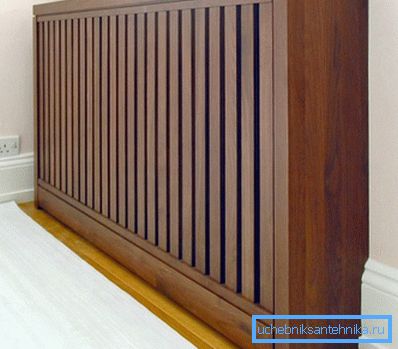
Of course, the main quality here is the environmental safety of the product and its specific appearance.
Such lattices will look organically in any interior - the main thing is to choose the color successfully. In addition, wood has a special feature - it brings a significant share of comfort to the room.
As for more practical characteristics, this is the case when it is easy to work with the material with your own hands, even without some experience.
In addition, the wooden elements required for the manufacture of the barrier are very inexpensive, and this makes the option affordable for everyone and interesting in the sense that you can think of almost any panel pattern.
Pay attention to the shortcomings of wood - it tends to crack and deform under the influence of moisture or temperature changes. Therefore, if you need to decorate the radiators in a house where it is impossible to provide a stable microclimate all the time, then it is better not to use wood. (See also the article Pipe box: features.)
Tip! If you really want to see wood in the interior, then purchase panels made of MDF - this material does not deteriorate due to external factors, but it does not differ in appearance from wood.
Plastic solutions
The advantages of plastic screens are in such moments:
- Low cost of products.
- Low weight.
- Ease and high speed of installation.
Well, the disadvantages are more than serious. Firstly, the material has a high level of toxicity during heating.
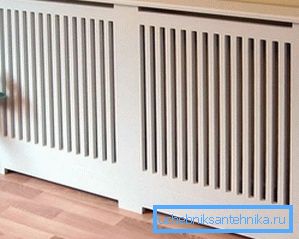
Secondly, the plastic is easy to scratch and just break. Thirdly, the interior with plastic panels does not look very solid. (See also the article How to close the heating battery: features.)
In general, we can say that this is a relatively good "economy option" for offices or production premises. But whether to apply this solution to your home is up to you, of course.
Tip: if you do decide to buy plastic, then at least do not get the cheapest material, since it is usually in it that the level of toxic fumes is very high.
This concludes our review, as you can see, this topic is quite simple to understand.
Conclusion
We thoroughly figured out what kind of decorative screens on radiators are, what they are made of and what features are typical for each type of product. We hope that now you can make the most correct choice!
If you want to find out more information on this topic, then you can view the additional video in our article.